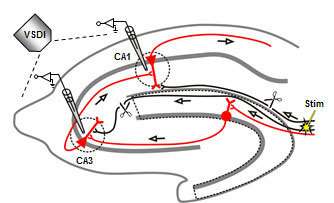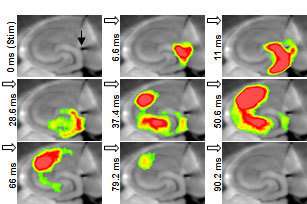Learning requires rhythmical activity of neurons

The hippocampus represents an important brain structure for learning. Scientists at the Max Planck Institute of Psychiatry in Munich discovered how it filters electrical neuronal signals through an input and output control, thus regulating learning and memory processes. Accordingly, effective signal transmission needs so-called theta-frequency impulses of the cerebral cortex. With a frequency of three to eight hertz, these impulses generate waves of electrical activity that propagate through the hippocampus. Impulses of a different frequency evoke no transmission, or only a much weaker one. Moreover, signal transmission in other areas of the brain through long-term potentiation (LTP), which is essential for learning, occurs only when the activity waves take place for a certain while. The scientists even have an explanation for why we are mentally more productive after drinking a cup of coffee or in an acute stress situation: in their experiments, caffeine and the stress hormone corticosterone boosted the activity flow.
When we learn and recall something, we have to concentrate on the relevant information and experience it again and again. Electrophysiological experiments in mice now show why this is the case. Scientists belonging to Matthias Eder´s Research Group measured the transmission of electrical impulses between neurons in the mouse hippocampus. Under the fluorescence microscope, they were able to observe in real time how the neurons forward signals.
Jens Stepan, a junior scientist at the Max Planck Institute of Psychiatry in Munich, stimulated the input region of the hippocampus the first time that specifically theta-frequency stimulations produce an effective impulse transmission across the hippocampal CA3/CA1 region. This finding is very important, as it is known from previous studies that theta-rhythmical neuronal activity in the entorhinal cortex always occurs when new information is taken up in a focused manner. With this finding, the researchers demonstrate that the hippocampus highly selectively reacts to the entorhinal signals. Obviously, it can distinguish important and, thus, potentially recollection-worth information from unimportant one and process it in a physiologically specific manner.

One possible reaction is the formation of the so-called long-term potentiation (LTP) of signal transmission at CA3-CA1 synapses, which is often essential for learning and memory. The present study documents that this CA1-LTP occurs only when the activity waves through the hippocampus take place for a certain time. Translating this to our learning behavior, to commit for instance an image to memory, we should intently view it for a while, as only then we produce the activity waves described long enough to store the image in our brain.
With this study, Matthias Eder and colleagues succeeded in closing a knowledge gap. "Our investigation on neuronal communication via the hippocampal trisynaptic circuit provides us with a new understanding of learning in the living organism. We are the first to show that long-term potentiation depends on the frequency and persistency of incoming sensory signals in the hippocampus," says Matthias Eder.
More information: Jens Stepan, Julien Dine, Thomas Fenzl, Stephanie A. Polta, Gregor von Wolff, Carsten T. Wotjak and Matthias Eder (2012) Entorhinal theta-frequency input to the dentate gyrus trisynaptically evokes hippocampal CA1 LTP, Frontiers in Neural Circuits, Volume 6, Article 64, 1-13.

















